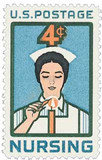
U.S. #1190
1961 4¢ Nursing
Issue Date: December 28, 1961
City: Washington, D.C.
Quantity: 145,350,000
Printed By: Bureau of Engraving and Printing
Printing Method: Giori Press
Perforations: 11
Color: ... more
U.S. #1190
1961 4¢ Nursing
Issue Date: December 28, 1961
City: Washington, D.C.
Quantity: 145,350,000
Printed By: Bureau of Engraving and Printing
Printing Method: Giori Press
Perforations: 11
Color: Blue, green, orange and black
U.S. #1190 was issued to honor the nursing profession.
America’s First Training Program for Nurses
In 1798, New York Hospital attending surgeon Dr. Valentine Seaman (1770-1817) recognized the need for a specially trained group of women to assist the doctors at his hospital. As a result, he began one of America’s first nurse training programs. Seaman instructed a class of about 24 women in anatomy, physiology, childcare, and mid-wifery. Two years later, some of his lectures were published with the title, Midwives’ Monitor and Mothers’ Mirror.
During the Civil War, Clara Barton helped bring the role of nurses to prominence. In 1881, she established the American Red Cross.
National Hospital Day
On May 12, 1921, the US celebrated National Hospital Day for the first time.
Matthew O. Foley, the managing editor of Hospital Management, conceived National Hospital Day. He saw it as a national healthcare event that could promote trust in America’s hospitals in the wake of the Spanish flu outbreak of 1918 that claimed more than 600,000 American lives. Because many people had died in hospitals, people started to fear them, but Foley wanted to help regain their trust.
President Warren G. Harding approved the holiday and declared the first National Hospital Day to be May 12, 1921. May 12 was selected because it was the birthday of Florence Nightingale, who is considered the founder of modern nursing. That first National Hospital Day, hospitals across the country invited people to come and see the modern advances they had made and help encourage people to trust them again.
In the years to come National Hospital Day continued to encourage hospitals to open their doors to the public to show people how safe they were and what they could expect for treatment. Some of these presentations included X-ray technology, occupational therapy, anesthetics, and more. As modern medicine evolved and improved, National Hospital Day helped to show these new innovations to the public. It also promoted the idea that the hospital was “the first place to go instead of the last.”
National Hospital Day continued to grow over the years, so much so that in 1953, it was expanded to National Hospital Week. This was meant to give hospitals more time to educate the public about medical care. In the years since, the week has become a celebration of the men and women who work in hospitals around the country every day.
Also celebrated during National Hospital Week is International Nurses Day. This day is also held on May 12 in honor of Florence Nightingale. A Nurses Day was first suggested in 1953. The US first celebrated Nurses Week in October 1954 to commemorate the 100th anniversary of Florence Nightingale’s mission to Crimea. In 1974, the International Council of Nurses established May 12 as International Nurses Day, while the US also celebrates National Nurses Week from May 6 to May 12.
Click here to view a flyer for the 1921 National Hospital Day in New Orleans.
Click here for more stamps honoring the medical field.










